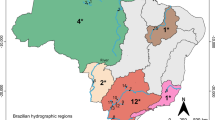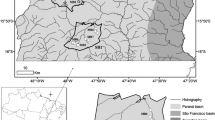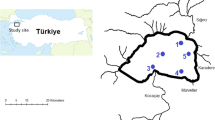Abstract
Eutrophication of rivers and streams in agricultural lands is one of the main threats for biodiversity and ecosystem functions. This study was focused on seven subtropical streams where agriculture is the predominant land use. We tested the hypothesis that (i) eutrophication causes a decrease in taxonomic and functional diversity of zooplankton, leading to potential consequences for the ecosystem integrity. Furthermore, given that the temporal variability in the environmental conditions of each stream may influence the species sorting mechanisms, we also hypothesized that (ii) streams with higher temporal environmental variability have greater taxonomic and functional alpha (α) and temporal beta (βt) diversity measures regardless of the trophic state. Thus, we characterized the streams according to their trophic state and analyzed the zooplankton composition, α and βt by using taxonomic and functional perspectives. We found differences in the zooplankton composition between mesotrophic and eutrophic streams. However, eutrophic streams supported similar taxonomic and functional α diversity and similar taxonomic βt diversity to mesotrophic ones. These results were mainly explained by the occurrence of rare species occupying different temporal niches in eutrophic systems. On the contrary, functional βt diversity was lower in the eutrophic streams, being nestedness the ecological mechanisms underlying the variability in the zooplankton functional groups. Streams with higher temporal environmental variability supported greater α taxonomic diversity. However, the βt diversity metrics showed no correlation with the environmental variability, suggesting that the environmental filters of the studied systems were the overriding determinants of species turnover. Our study suggests that both taxonomic and functional perspectives should be considered to improve our knowledge on the biotic responses to environmental changes. Also, among all metrics analyzed on the zooplankton community, functional βt diversity was the most sensitive indicator of the eutrophication impact.








Similar content being viewed by others
References
Abonyi, A., Horváth, Z., & Ptacnik, R. (2018). Functional richness outperforms taxonomic richness in predicting ecosystem functioning in natural phytoplankton communities. Freshwater Biology, 63(2), 178–186.
Anderson, M. J., Ellingsen, K. E., & McArdle, B. H. (2006). Multivariate dispersion as a measure of beta diversity. Ecology Letters, 9, 683–693.
Barnett, A. J., Finlay, K., & Beisner, B. E. (2007). Functional diversity of crustacean zooplankton communities: towards a trait-based classification. Freshwater Biology, 52(5), 796–813.
Baselga, A. (2010). Partitioning the turnover and nestedness components of beta diversity. Global Ecology and Biogeography, 19(1), 134–143.
Bhagowati, B., & Ahamad, K. U. (2019). A review on lake eutrophication dynamics and recent developments in lake modeling. Ecohydrology & Hydrobiology, 19(1), 155–166.
Bini, L. M., Landeiro, V. L., Padial, A. A., Siqueira, T., & Heino, J. (2014). Nutrient enrichment is related to two facets of beta diversity for stream invertebrates across the United States. Ecology, 95(6), 1569–1578.
Braghin, L. D. S. M., Almeida, B. D. A., Amaral, D. C., Canella, T. F., Gimenez, B. C. G., & Bonecker, C. C. (2018). Effects of dams decrease zooplankton functional β-diversity in river-associated lakes. Freshwater Biology, 63(7), 721–730.
Braz, J. E. M., Dias, J. D., Bonecker, C. C., & Simões, N. R. (2020). Oligotrophication affects the size structure and potential ecological interactions of planktonic microcrustaceans. Aquatic Sciences, 82, 59.
Cadotte, M. W., Carscadden, K., & Mirotchnick, N. (2011). Beyond species: functional diversity and the maintenance of ecological processes and services. Journal of Applied Ecology, 48(5), 1079–1087.
Claps, M. C., Gabellone, N. A., & Neschuk, N. C. (2009). Influence of regional factors on zooplankton structure in a saline lowland river: the Salado River (Buenos Aires province, Argentina). River Research and Applications, 25(4), 453–471.
Cochero, J., Romaní, A. M., & Gómez, N. (2013). Delayed response of microbial epipelic biofilm to nutrient addition in a Pampean stream. Aquatic Microbial Ecology, 69(2), 145–155.
Conde-Porcuna, J. M., Ramos-Rodríguez, E., & Morales-Baquero, R. (2004). El zooplancton como integrante de la estructura trófica de los ecosistemas lénticos. Revista Ecosistemas, 13(2).
Cook, S. C., Housley, L., Back, J. A., & King, R. S. (2018). Freshwater eutrophication drives sharp reductions in temporal beta diversity. Ecology, 99(1), 47–56.
De Geronimo, E., Aparicio, V. C., Bárbaro, S., Portocarrero, R., Jaime, S., & Costa, J. L. (2014). Presence of pesticides in surface water from four sub-basins in Argentina. Chemosphere, 107, 423–431.
De Paggi, S. B. J., & Devercelli, M. (2011). Land use and basin characteristics determine the composition and abundance of the microzooplankton. Water, Air, & Soil Pollution, 218(1–4), 93–108.
Debastiani, C., Meira, B. R., Lansac-Töha, M. N., Velho, L. F. M., & Lansac-Töha, F. A. (2016). Protozoa ciliates community structure in urban streams and their environmental use as indicators. Brazilian Journal of Biology, 76, 1043–1053.
Di Marzio, W. D., Sáenz, M. E., Alberdi, J. L., Fortunato, N., Cappello, V., Montivero, C., & Ambrini, G. (2010). Environmental impact of insecticides applied on biotech soybean crops in relation to the distance from aquatic ecosystems. Environmental Toxicology and Chemistry, 29(9), 1907–1917.
Díaz, S., & Cabido, M. (2001). Vive la diffe’rence: plant functional diversity matters to ecosystem processes. Trends in Ecology & Evolution, 12, 646–655.
Ding, N., Yang, W., Zhou, Y., González-Bergonzoni, I., Zhang, J., Chen, K., Vidal, N., Jeppesen, E., Liu, Z., & Wang, B. (2017). Different responses of functional traits and diversity of stream macroinvertebrates to environmental and spatial factors in the Xishuangbanna watershed of the upper Mekong River basin, China. Science of the Total Environment, 574, 288–299.
Dodds, W. K., & Oakes, R. M. (2006). Controls on nutrients across a prairie stream watershed: land use and riparian cover effects. Environmental Management, 37(5), 634–646.
Dodds, W. K., & Smith, V. H. (2016). Nitrogen, phosphorus, and eutrophication in streams. Inland Waters, 6(2), 155–164.
Etchegoyen, M. A., Ronco, A. E., Almada, P., Abelando, M., & Marino, D. J. (2017). Occurrence and fate of pesticides in the Argentine stretch of the Paraguay-Paraná basin. Environmental Monitoring and Assessment, 189(2), 63.
Flynn, D. F., Gogol-Prokurat, M., Nogeire, T., Molinari, N., Richers, B. T., Lin, B. B., et al. (2009). Loss of functional diversity under land use intensification across multiple taxa. Ecology Letters, 12(1), 22–33.
Fontaneto, D., Melone, G., & Ricci, C. (2005). Connectivity and nestedness of the meta-community structure of moss dwelling bdelloid rotifers along a stream. In Aquatic Biodiversity II (pp. 131–136). Dordrecht, Springer.
Frau, D., Medrano, J., Calvi, C., & Giorgi, A. (2019). Water quality assessment of a neotropical pampean lowland stream using a phytoplankton functional trait approach. Environmental Monitoring and Assessment, 191(11), 681.
Freeman, M. C., Pringle, C. M., & Jackson, C. R. (2007). Hydrologic connectivity and the contribution of stream headwaters to ecological integrity at regional scales 1. JAWRA Journal of the American Water Resources Association, 43(1), 5–14.
Gallego, I., Davidson, T. A., Jeppesen, E., Pérez-Martínez, C., Sánchez-Castillo, P., Juan, M., Fuentes-Rodríguez, F., León, D., Peñalver, P., Toja, J., & Casas, J. J. (2012). Taxonomic or ecological approaches? Searching for phytoplankton surrogates in the determination of richness and assemblage composition in ponds. Ecological Indicators, 18, 575–585.
García-Chicote, J., Armengol, X., & Rojo, C. (2019). Zooplankton species as indicators of trophic state in reservoirs from Mediterranean river basins. Inland Waters, 9(1), 113–123.
García-García, P. L., Martínez-Jerónimo, F., Vázquez, G., Favila, M. E., & Novelo-Gutiérrez, R. (2012). Effects of land use on water quality and Ceriodaphnia dubia reproduction. Hidrobiológica., 22, 229–243.
GeoINTA. (2014) Mapa de suelos de la Provincia de Santa Fe. Inst. Nac. Tenología Agropecu. Available from: http://www.geointa.inta.gob.ar/2014/05/22/mapa-de-suelos-de-la-provincia-de-santa-fe/
Goździejewska, A., Glińska-Lewczuk, K., Obolewski, K., Grzybowski, M., Kujawa, R., Lew, S., & Grabowska, M. (2016). Effects of lateral connectivity on zooplankton community structure in floodplain lakes. Hydrobiologia, 774(1), 7–21.
Gutierrez, M. F., Molina, F. R., Frau, D., Mayora, G., & Battauz, Y. (2020). Interactive effects of fish predation and sublethal insecticide concentrations on freshwater zooplankton communities. Ecotoxicology and Environmental Safety, 196, 110497.
Hammer, Ø., Harper, D. A., & Ryan, P. D. (2001). PAST: Paleontological statistics software package for education and data analysis. Palaeontologia Electronica, 4(1), 9.
Hanazato, T. (2001). Pesticide effects on freshwater zooplankton: an ecological perspective. Environmental Pollution, 112(1), 1–10.
Harrison, S., McAree, C., Mulville, W., & Sullivan, T. (2019). The problem of agricultural ‘diffuse’pollution: getting to the point. Science of the Total Environment, 677, 700–717.
Hawkins, C. P., Mykrä, H., Oksanen, J., & Vander Laan, J. J. (2015). Environmental disturbance can increase beta diversity of stream macroinvertebrate assemblages. Global Ecology and Biogeography, 24(4), 483–494.
Heino, J. (2008). Patterns of functional biodiversity and function-environment relationships in lake littoral macroinvertebrates. Limnology and Oceanography, 53(4), 1446–1455.
Hildrew, A. G., & Townsend, C. R. (2007). Freshwater biology–looking back, looking forward. Freshwater Biology, 52(10), 1863–1867.
Hooper, D. U., Adair, E. C., Cardinale, B. J., Byrnes, J. E., Hungate, B. A., Matulich, K. L., et al. (2012). A global synthesis reveals biodiversity loss as a major driver of ecosystem change. Nature, 486(7401), 105–108.
Illyová, M., & Pastuchová, Z. (2012). The zooplankton communities of small water reservoirs with different trophic conditions in two catchments in western Slovakia. Limnologica, 42(4), 271–281.
Jeppesen, E., Søndergaard, M., Pedersen, A. R., Jürgens, K., Strzelczak, A., Lauridsen, T. L., & Johansson, L. S. (2007). Salinity induced regime shift in shallow brackish lagoons. Ecosystems, 10(1), 48–58.
Jeppesen, E., Moss, B., Bennion, H., Carvalho, L., DeMeester, L., Feuchtmayr, H., et al. (2010). Interaction of climate change and eutrophication. Climate Change Impacts on Freshwater Ecosystems, 119–151.
Jeppesen, E., Nõges, P., Davidson, T. A., Haberman, J., Nõges, T., Blank, K., et al. (2011). Zooplankton as indicators in lakes: a scientific-based plea for including zooplankton in the ecological quality assessment of lakes according to the European water framework directive (WFD). Hydrobiologia, 676(1), 279–297.
Korinek, V. (2002). Cladocera. A guide to tropical freshwater zooplankton. Identification, ecology and impact on fisheries, 69–122.
Koste, W., 1978. Rotatoria. Die Radertiere Mitteleuropas, Gebruder Borntraeger.
Krztoń, W., Kosiba, J., Pociecha, A., & Wilk-Woźniak, E. (2019). The effect of cyanobacterial blooms on bio-and functional diversity of zooplankton communities. Biodiversity and Conservation, 28(7), 1815–1835.
Legendre, P., & Legendre, L. (1998). Numerical ecology: developments in environmental modelling. Developments in Environmental Modelling, 20, 1.
Lopes, V. G., Branco, C. W. C., Kozlowsky-Suzuki, B., & Bini, L. M. (2019). Zooplankton temporal beta diversity along the longitudinal axis of a tropical reservoir. Limnology, 20(1), 121–130.
Magurran, A. E. (2013). Measuring biological diversity. Hoboken: Wiley.
Mano, H., & Tanaka, Y. (2016). Mechanisms of compensatory dynamics in zooplankton and maintenance of food chain efficiency under toxicant stress. Ecotoxicology, 25(2), 399–411.
Mesa, L., Mayora, G., Saigo, M., & Giri, F. (2015). Nutrient dynamics in wetlands of the middle Paraná River subjected to rotational cattle management. Wetlands, 35(6), 1117–1125.
Mouchet, M. A., Villéger, S., Mason, N. W., & Mouillot, D. (2010). Functional diversity measures: an overview of their redundancy and their ability to discriminate community assembly rules. Functional Ecology, 24(4), 867–876.
Mugni, H., Paracampo, A., & Bonetto, C. (2013). Nutrient concentrations in a pampasic first order stream with different land uses in the surrounding plots (Buenos Aires, Argentina). Bulletin of Environmental Contamination and Toxicology, 91(4), 391–395.
Nevalainen, L., & Luoto, T. P. (2017). Relationship between cladoceran (Crustacea) functional diversity and lake trophic gradients. Functional Ecology, 31(2), 488–498.
Obertegger, U., & Manca, M. (2011). Response of rotifer functional groups to changing trophic state and crustacean community. Journal of Limnology, 70, 231–238.
Paggi, J. C. (1979). Revisión de las especies argentinas del género Bosmina Baird agrupadas en el sugénero Neobosmina Lieder (Crustacea, Cladocera). Acta Zool Lilloana, 35, 137–162.
Paggi, J. C. (1995). Crustacea cladocera. Ecosistemas de Aguas Continentales, Metodologías para su estudio.
Paracampo, A., Marrochi, N., García, I., Maiztegui, T., Carriquiriborde, P., Bonetto, C., & Mugni, H. (2020). Fish assemblages in Pampean streams (Buenos Aires, Argentina): relationship to abiotic and anthropic variables. Anais da Academia Brasileira de Ciências, 92(2).
Parmar, T. K., Rawtani, D., & Agrawal, Y. K. (2016). Bioindicators: the natural indicator of environmental pollution. Frontiers in Life Science, 9(2), 110–118.
Perez Rocha, M., Bini, L. M., Grönroos, M., Hjort, J., Lindholm, M., Karjalainen, S. M., Tolonen, K. E., & Heino, J. (2019). Correlates of different facets and components of beta diversity in stream organisms. Oecologia, 191(4), 919–929.
R Development Core Team. (2015). R: a language and environment for statistical computing. Viena: R Foundation for Statistical Computing.
Regaldo, L., Gutierrez, M. F., Reno, U., Fernández, V., Gervasio, S., Repetti, M. R., & Gagneten, A. M. (2018). Water and sediment quality assessment in the Colastiné-Corralito stream system (Santa Fe, Argentina): impact of industry and agriculture on aquatic ecosystems. Environmental Science and Pollution Research, 25(7), 6951–6968.
Ringuelet, R. A. (1958). Los Crustáceos Copépodos de las aguas continentales de la República Argentina. Contribuciones científicas. Zoología. Facultad de Ciencias Exactas y Naturales. UBA, 1(2).
Rodríguez Capítulo, A., Gómez, N., Giorgi, A., & Feijoó, C. (2010). Global changes in pampean lowland streams (Argentina): implications for biodiversity and functioning. In Global change and river ecosystems—implications for structure, function and ecosystem services (pp. 53–70). Dordrecht: Springer.
Sarma, S. S. S., Nandini, S., & Gulati, R. D. (2005). Life history strategies of cladocerans: comparisons of tropical and temperate taxa. In Aquatic Biodiversity II (pp. 315–333). Springer, Dordrecht.
Schäfer, R. B., Kühn, B., Malaj, E., König, A., & Gergs, R. (2016). Contribution of organic toxicants to multiple stress in river ecosystems. Freshwater Biology, 61(12), 2116–2128.
Simões, N. R., Lansac-Toˆha, F. A., & Bonecker, C. C. (2013). Drought disturbances increase temporal variability of zooplankton community structure in floodplains. International Review of Hydrobiology, 98, 24–33.
Simões, N. R., Braghin, L. S., Dure, G. A., Santos, J. S., Sonoda, S. L., & Bonecker, C. C. (2020). Changing taxonomic and functional beta-diversity of cladoceran communities in northeastern and South Brazil. Hydrobiologia., 847, 3845–3856.
Siqueira, T., Lacerda, C. G. L. T., & Saito, V. S. (2015). How does landscape modification induce biological homogenization in tropical stream metacommunities? Biotropica, 47(4), 509–516.
Socolar, J. B., Gilroy, J. J., Kunin, W. E., & Edwards, D. P. (2016). How should beta-diversity inform biodiversity conservation? Trends in Ecology & Evolution, 31(1), 67–80.
Sokal, R. R., & Rohlf, F. J. (1981). Biometry: the principles and practice of statistics in biological research.
Sokal, R. R., Rohlf, F. J., & Lahoz León, M. (1979). Biometría: Principios y métodos estadísticos en la investigación biológica.
Strayer, D. L., Beighley, R. E., Thompson, L. C., Brooks, S., Nilsson, C., Pinay, G., & Naiman, R. J. (2003). Effects of land cover on stream ecosystems: roles of empirical models and scaling issues. Ecosystems, 6(5), 407–423.
Ter Braak, C. J., & Smilauer, P. (2002). CANOCO reference manual and CanoDraw for Windows user's guide: software for canonical community ordination (version 4.5). www. canoco. com.
Tilman, D., Fargione, J., Wolff, B., D'Antonio, C., Dobson, A., Howarth, R., et al. (2001). Forecasting agriculturally driven global environmental change. Science, 292(5515), 281–284.
Vaughn, C. C. (2010). Biodiversity losses and ecosystem function in freshwaters: emerging conclusions and research directions. BioScience, 60(1), 25–35.
Vieira, N., & Bio, A. (2011). Spatial and temporal variability of water quality and zooplankton in an artisanal salina. Journal of Sea Research, 65(2), 293–303.
Villéger, S., Mason, N. W. H., & Mouillot, D. (2008). New multidimensional functional diversity indices for a multifaceted framework in functional ecology. Ecology, 89, 2290–2301.
Wang, J., Pan, F., Soininen, J., Heino, J., & Shen, J. (2016). Nutrient enrichment modifies temperature-biodiversity relationships in large-scale field experiments. Nature Communications, 7(1), 1–9.
Wetzel, R. G. (1983). Limnology (2nd ed.). New York: Saunders Collage Pub.
Xiong, W., Ni, P., Chen, Y., Gao, Y., Li, S., & Zhan, A. (2019). Biological consequences of environmental pollution in running water ecosystems: A case study in zooplankton. Environmental Pollution, 252, 1483–1490.
Acknowledgments
We are grateful to Consejo Nacional de Investigaciones Científicas y Técnicas (CONICET), and Agencia Santafesina de Ciencia, Tecnología e Innovación (ASACTeI 2010-045-16, PI: Magdalena Licursi) for the financial support. We thank all members of the project, E. Creus for field assistance, C. Mora for her kind assistance with nutrients processing, and P. Scarabotti for providing information on fish species.
Funding
This study received financial support from Consejo Nacional de Investigaciones Científicas y Técnicas (CONICET), and Agencia Santafesina de Ciencia, Tecnología e Innovación (ASACTeI 2010-045-16, PI: Magdalena Licursi).
Author information
Authors and Affiliations
Corresponding author
Additional information
Publisher’s note
Springer Nature remains neutral with regard to jurisdictional claims in published maps and institutional affiliations.
Supplementary Information
ESM 1
Appendix I: Characterization of zooplankton species according seven functional traits: mean body length, feeding type, food source, habitat, reproduction type, life cycle and escape ability. (XLSX 17 kb)
ESM 2
Appendix II: Results of the ANOVA and Tukey post hoc tests for the limnological and physicochemical variables of seven Pampean streams (S1-S7). (DOCX 19 kb)
ESM 3
Appendix III: List of zooplankton species found in the seven Pampean streams (S1-S7). (XLSX 15 kb)
Rights and permissions
About this article
Cite this article
Gutierrez, M.F., Simões, N.R., Frau, D. et al. Responses of stream zooplankton diversity metrics to eutrophication and temporal environmental variability in agricultural catchments. Environ Monit Assess 192, 792 (2020). https://doi.org/10.1007/s10661-020-08766-5
Received:
Accepted:
Published:
DOI: https://doi.org/10.1007/s10661-020-08766-5




